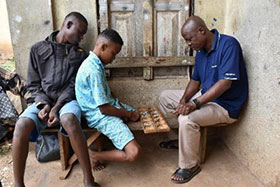Difficulties in changing perspectives

Photo: One of the examples of clues that indicates connections between arts and things that are usually not considered as part of arts. An owner of an art supply store playing “ayo”, a local board game (right), with a secondary school student in the neighborhood. Photographed by the author, 4th September 2023, Ile-Ife, Nigeria.
OGATA, Shirabe
(Assistant Professor, April 2024)
Having attempted to reveal ways of being of arts in Nigeria, I have been considering what arts are from a perspective of cultural anthropology. However, it was not that I have been learning anthropology right from the beginning, nor have I always been will ing to continue research for the rest of my life.
I visited Nigeria for the first time when I was a second year undergraduate student of the history of African arts. Having been enthusiastic to write about the latest information about contemporary arts of Nigeria at the beginning of the twenty first centu ry, I stayed in Ile Ife, a provincial city of Nigeria. But what I witnessed was some artworks that looked too “rough” and looked like “copies” of other artworks, which were far different from what I expected after learning African arts at the University in London. I was disappointed by the fact that there were only a few arts that were “sophisticated” and had very much “African” features. I was even fed up with artists asking for money by selling their “similar or copied” artworks. When I left Nigeria in September 2003, I decided not to continue the study of African arts.
In September 2023, however, I found myself still visiting and interviewing artist, their studios, shops, customers, acquaintances, friends, and families. There is somebody who continues to carve wooden African sculptures for customers in Brazil; who paints portraits based on demands of local people; who prepares for exhibitions in the largest commercial city of Lagos with plastic scraps; who carves decorative chess boards for the first time for somebody who might become his customer; who paints murals of hotels. Some interact with the artists such as their customers, families, apprentices, seniors and fellows, neighbors, and church members. There are also existing institutions that determine their activities and also new institutions made by them, sense and sensuosity that evoke people and make them create arts, bodies, and beliefs that support their labor. I became able to focus on these elements and realize how important it is that such arts and things that are not considered to be part of arts are mutually connected like nets, interacted and overlapped with because my supervisor at undergraduate course gave me a lot of academic advices, because people in Nigeria have been accepting me in the last twenty years, and because I learned cultural anthropology at the postgraduate course.
Viewing arts within a category or concept of arts, one can easily take arts for granted when a group of things and practices called arts are studied and researched. Based on individual and institutional sense of value, one can innocently make a selection t hrough exhibition and introduction to artworks. I would call this a trap of arts and this phenomenon occurs to someone who knows about arts quite well just like it happened to me on my first visit to Nigeria. This could cause discrimination and prejudice and could even hurt someone . It is fieldwork and study at university and research institutions that make one realize the existence of the trap. I would like to continue my research as it is always not easy at all to change my perspective.
Copyright © 2010 Research Institute for Languages and Cultures of Asia and Africa. All Rights Reserved.
